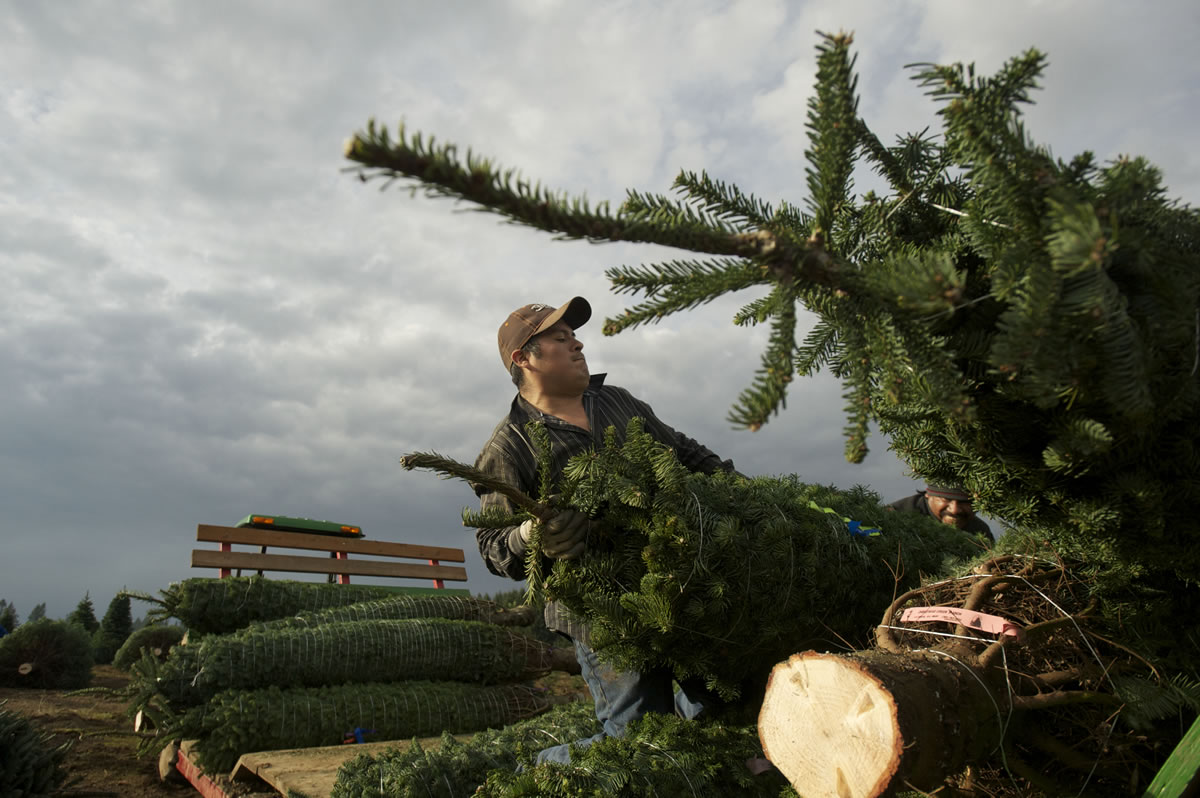LA CENTER — Cut it. Bale it. Load it. Repeat.
The process of harvesting Christmas trees sounds simple enough on its face. Then you throw in months of preparation, a dizzying slate of orders, unpredictable weather and a wreath business on top of it.
One might say that requires always thinking ahead. Evelyn Casella calls it “stressing ahead.”
“Every time a truck goes out, it’s like, ‘there’s one more down the road,'” said Casella, who runs Christmas Creek Ranch outside La Center with her husband Gary.
Christmas Creek is one of hundreds of tree growers across the state currently working their way through the annual Christmas harvest. Washington is one of the top producers in the country, harvesting about 2.3 million trees last year, according to the Pacific Northwest Christmas Tree Association. Oregon is by far the biggest supplier of Christmas trees, producing 6.4 million in 2011.
For Christmas Creek and other wholesalers, some of the busiest times are the days leading up to Thanksgiving. That’s when many buyers are gathering their inventory to roll out on tree lots shortly after the holiday. Earlier this week, Casella expected as many as three trucks per day coming to pick up loads.
The frenetic pace generally slows some once Thanksgiving passes. But by the end of the season, Christmas Creek and neighboring Highland Acres typically ship between 8,000 and 10,000 trees per year combined, said Jim Ehlbeck, Casella’s brother.
“I think the most surprising thing that people miss is simply the mass,” said Ehlbeck, who owns Highland Acres. “We will probably ship about 500 tons of material.”
Most of those trees will end up in living rooms far away from Clark County by Christmas Day. Casella’s operation has customers in various parts of California, Arizona, and even as far away as Houston, she said. Many are longtime buyers who run seasonal Christmas tree lots as a side venture to other businesses, she said.
Casella and Ehlbeck take a methodical approach to the tree harvest. Trees are cut and prioritized based on upcoming orders, then sorted and tagged by height and tree type. Organized piles wait outside the Christmas Creek office until loading trucks — sometimes partially full from previous stops — come to haul them away.
Trucks shuffling their schedules can cause headaches for growers depending on what types of trees are ready, Casella said. So can wintry weather. But amid all the uncertainty that goes with the business, there’s at least one constant that keeps the level of urgency high.
“Christmas still comes,” Casella said.
Not all of Washington’s Christmas trees come from private growers. The state Department of Natural Resources has four Christmas tree plantations totaling 201 acres, according to DNR spokeswoman Jane Chavey. The agency also has four leases for bough harvesting on its land. Those cover a total of 28,238 acres, mostly in Southwest Washington, Chavey said.
Casella established her wreath business in 1981, long before she and her husband began running Christmas Creek Ranch. Her materials are cut from the Mount St. Helens area, she said. The operation functions mostly separate from the tree harvest, and gives Casella a perpetually fir-scented office.
The juggling act that goes into getting thousands of trees and wreaths out the door leaves little time to spare, Casella said — and starts well before the busy holiday season. Many orders are placed in the summer. Tree topping and trimming happens soon after the Fourth of July. The farm must also stay on top of weeding and other upkeep.




